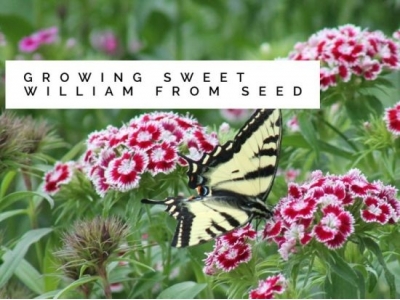Sweet William: Growing from Seed

The Sweet William flower (Dianthus barbatus), hardy in USDA plant hardiness zones 3 through 9, is charming tucked in containers, mixed with other perennials, or as a border in any flower bed. But, before you buy flats of expensive nursery plants, consider growing Sweet William from seed. After all, this short-lived perennial self-sows prolifically under normal garden conditions and will continually regenerate itself from year to year. Any plant that can self-seed in the garden is a shoe-in for seed starting success.
SOWING SEED IN THE GARDEN
Before you plant Sweet William seeds, find the ideal location for them. They need full sun and moderately rich, well-drained soil. Sweet William is plagued by a host of fungal diseases in wet, heavy soil. Amend these soils with compost or choose another spot. In hot, Southern climates, plant Sweet William in a place with light shade.
Remove any weeds and rocks and till the soil to a depth of 8 inches. Plant Sweet William in summer, after the last frost. Sow seeds 3 inches apart and ¼ inch deep. Keep the soil evenly moist. Don’t allow it to dry out while seeds are germinating.
Once the seeds germinate and stand 3 inches tall, thin them to at 12 inches apart. As the plants grow, you may have to thin them again. Sweet William grows slowly, but eventually can grow 3 feet high and 2 feet wide. Sweet William plants needs plenty of air circulation so don’t overcrowd them.
Sweet William seeds sown directly in the garden won’t bloom the first year. Don’t give up on them though. Come next spring, you’ll have prolific blooms.
You may also sow Sweet William seeds in containers and pots in summer. Use a lightweight potting soil and sow seeds ¼ inch deep. Pots and containers dry out more quickly than the garden, so be sure to water frequently.
Give your Sweet William plants a dose of all-purpose fertilizer every 6 to 8 weeks during the growing season. Cut them back if they become unruly or cut the fragrant blooms and bring them indoors. Sweet William plants attract butterflies, bees and hummingbirds, making them a welcome addition to any perennial bed.
STARTING SEED INDOORS
Don’t want to wait a year for blooms? A faster option is to plant Sweet William indoors 6 to 8 weeks before the last frost. All you need is a seed-starting tray, a starter mix and some seeds. To plant Sweet William indoors, fill plastic pots or a seed-starting tray with a seed-starting mix. Or, make your own inexpensive mix by combining two parts soil-less potting mix with one part washed sand, such as the kind you’d buy for a child’s sandbox. Add 1 tablespoon slow release fertilizer for every 1 cubic foot of starting mix.
Cover the starting mix with a thin layer of small gravel. The gravel should be about the size of BB pellets. Sprinkle the Sweet William seeds on top of the gravel, but don’t cover them with soil. This process cuts your risk of damping off disease, by keeping seeds moist, but not too moist.
Spray the seeds with water from a spray bottle and cover the trays with plastic wrap. Check them daily to make sure the gravel is slightly moist and water as needed.
Once the seeds germinate, take off the plastic wrap and set the tray in full sun. Again, continue to monitor soil moisture levels and water to keep the gravel slightly moist. Once the plants stand about 1 inch high, transfer them to individual 3-inch pots. When they stand 3-4 inches high, it’s time to move them outdoors, either into pots or into your garden. You’ll probably even have enough plants to share with friends and neighbors.
Related news
 How to grow blueberries
How to grow blueberries Fresh blueberries are a recent addition to Australian fruit bowls and are rarely grown in home gardens. However, as the succulent fruit becomes increasingly
 10 Types of Garden Squash
10 Types of Garden Squash Whether you prefer it steamed, sautéed, baked or in bread, squash is one of Mother Nature’s super foods. Squash is high in vitamin A, antioxidants and fiber.
 Growing Potatoes From Store Bought Potatoes
Growing Potatoes From Store Bought Potatoes When deep winter snows cover the ground, many of us tend to dream of harvesting succulent fresh vegetables and fruits.